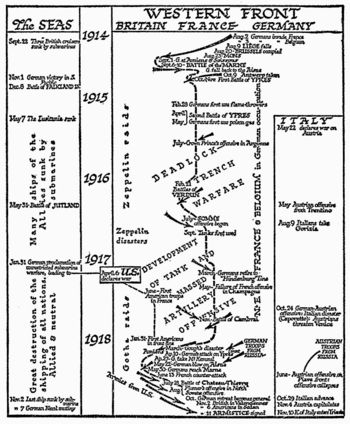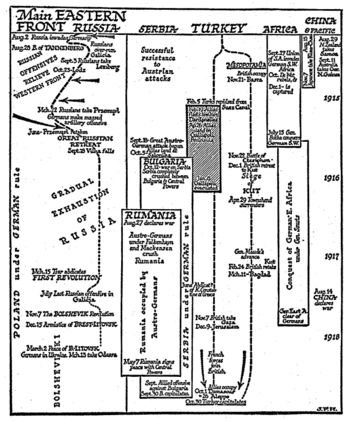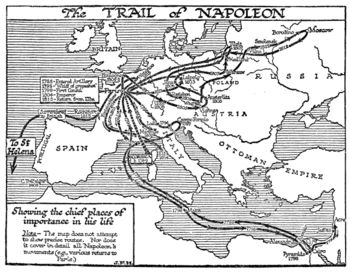Talk:World War I
Machine guns and similiar technology and its effect on tactics/strategies
I'm not an expert on WWI, but it seems that there should be some mention of the effect machine guns and the like had on casualty tolls more than the bit mentioned in the Trenches subsection. I read and was taught that the high number of casualties was due in part to the use of outdated tactics and strategies from before the widespread use of highly accurate guns with high rates of fire, leading to such disasters as fatal charges across no-man's-land. Perhaps somebody more knowledgeable might be able to expand upon this in the article? Andrew Chong 09:44, 5 August 2007 (CDT)
Charts
I'm sure they'd be useful, but they aren't really readable. --Larry Sanger 00:08, 9 September 2007 (CDT)
- lotsof confusion re WWI because so many things were happening at once in many different places. Chart helps sort them out. (more legibility would be good idea--needs someone to rescan 2 pages from H.G, Wells Outline of History (1922) Richard Jensen 00:57, 9 September 2007 (CDT)
Right now, the chart is more embarrassing than helpful, because it is literally unreadable. I have removed it until it is rescanned. It can be found at Image:Ww1-summary.jpg --Larry Sanger 20:31, 23 September 2007 (CDT)
Richard, it is contrary to policy to revert without first answering a person's explanation. I should think this is particularly obvious when the person you are reverting is the editor-in-chief. Do not revert me again. --Larry Sanger 20:44, 23 September 2007 (CDT)
- I can read every word on the chart and it is a very useful device to keep track of a huge number of events all over the world. If someone wants to make a more legible copy or rescan it from HG Wells, then great. That is very unlikely to happen if it gets removed. Richard Jensen 20:45, 23 September 2007 (CDT)
Text here was removed by the Constabulary on grounds of civility. (The author may replace this template with an edited version of the original remarks.)
- This has absolutely nothing to do with knowledge of WWI and you know it. The poor quality of the image rendered it pointless, and even embarrassing, to include. I am a better judge of this than you are, I dare say, precisely because I don't know as much about WWI as you do. You can fill in the gaps and thereby glean more from the image. I can't, and so I assume most readers won't be able to. --Larry Sanger 20:58, 23 September 2007 (CDT)
- perhaps is just a problem of poor eyesight--what lines of text are unreadable? I can read them all. Richard Jensen 20:55, 23 September 2007 (CDT)
- No, I can get as close to the screen as I want, and I am using the most common configuration (Windows + IE7). Still can't read the smaller text. --Larry Sanger 20:58, 23 September 2007 (CDT)
- I have looked at the chart in both IE7 and Firefox and I can read the LARGE letters, some of the middle-sized, and none of the small stuff -- it's just a blur. I have a high-resolution screen, a very high quality graphics cards, and *excellent* computer glasses that make my eyesight about 20-15 when looking at a monitor. So I doubt if the problem lies with Larry. Hayford Peirce 21:07, 23 September 2007 (CDT)
- The image is pretty embarrassing, I think. It's so bad upon first glance, the average reader would not bother even trying to read it. I'll scan the image this week and upload one nice and clear. The book is in the library at the college I work at. —Stephen Ewen (Talk)
- it's an empirical question on legibility, which of course is a common problem with maps as well. If we erase an image because ther are a few words some people cannot read then we lose most historic maps as well as this chart. (The HG Wells books was a runaway best seller with million of copies out there. Someone can get a copy, use the photocopier to enlarge it, then scan. This image came from a mediocre Google scan) Richard Jensen 21:10, 23 September 2007 (CDT)
- You don't photocopy first, you scan well. But anyway, Richard, are there other graphics from the book you'd like scanned besides this one? —Stephen Ewen (Talk) 21:28, 23 September 2007 (CDT)
- I had best luck by enlarging the image with the xerox machine because it has much better resolution than the scanner. Then I scan at 300dpi, thereby picking up a lot more detail than if i scanned the book directly. The Wells book has many terrific maps and portraits by artist J. F. Horrabin. Richard Jensen 21:47, 23 September 2007 (CDT)
Good scanners have interpolation. That enlarges in a superior way. So do tell me if you want other specific images from the book; otherwise, I'll just go with getting this one. —Stephen Ewen (Talk) 23:06, 23 September 2007 (CDT)
- better do p 369 before somebody decides to erase it too.
"Image:Napoleon-map.jpg Richard Jensen 23:38, 23 September 2007 (CDT)
Here ya go. —Stephen Ewen (Talk) 01:54, 25 September 2007 (CDT)
- Nice job! thanks. Richard Jensen 10:02, 25 September 2007 (CDT)


